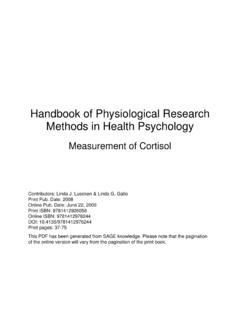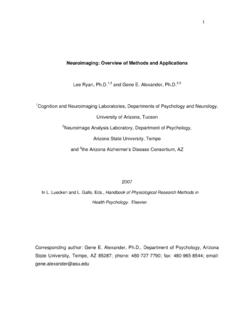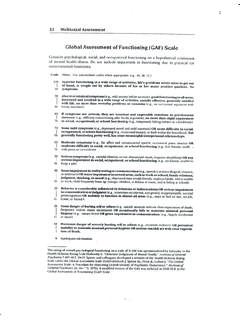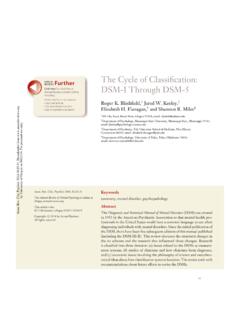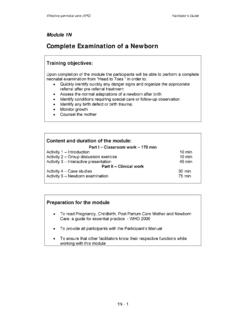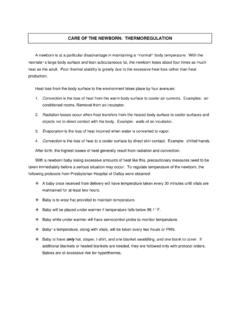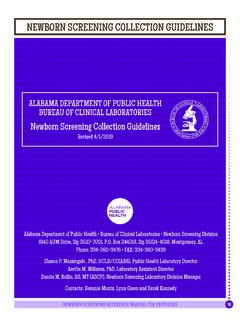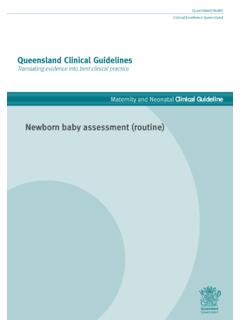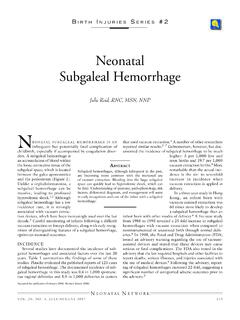Transcription of Chapter 2 – Normal Human Sleep : An Overview
1 Carskadon, , & Dement, (2011). Monitoring and staging Human Sleep . In Kryger, T. Roth, & Dement (Eds.), Principles and practice of Sleep medicine, 5th edition, (pp 16-26). St. Louis: Elsevier Saunders. Chapter 2 Normal Human Sleep : An Overview Mary A. Carskadon, William C. Dement Abstract Normal Human Sleep comprises two states rapid eye movement (REM) and non REM (NREM) Sleep that alternate cyclically across a Sleep episode. State characteristics are well defined: NREM Sleep includes a variably synchronous cortical electroencephalogram (EEG; including Sleep spindles, K-complexes, and slow waves) associated with low muscle tonus and minimal psychological activity; the REM Sleep EEG is desynchronized, muscles are atonic, and dreaming is typical.
2 A nightly pattern of Sleep in mature humans sleeping on a regular schedule includes several reliable characteristics: Sleep begins in NREM and progresses through deeper NREM stages (stages 2, 3, and 4 using the classic definitions, or stages N2 and N3 using the updated definitions) before the first episode of REM Sleep occurs approximately 80 to 100 minutes later. Thereafter, NREM Sleep and REM Sleep cycle with a period of approximately 90 minutes. NREM stages 3 and 4 (or stage N3) concentrate in the early NREM cycles, and REM Sleep episodes lengthen across the night. Age-related changes are also predictable: newborn humans enter REM Sleep (called active Sleep ) before NREM (called quiet Sleep ) and have a shorter Sleep cycle (approximately 50 minutes); coherent Sleep stages emerge as the brain matures during the first year.
3 At birth, active Sleep is approximately 50% of total Sleep and declines over the first 2 years to approximately 20% to 25%. NREM Sleep slow waves are not present at birth but emerge in the first 2 years. Slow-wave Sleep (stages 3 and 4) decreases across adolescence by 40% from preteen years and continues a slower decline into old age, particularly in men and less so in women. REM Sleep as a percentage of total Sleep is approximately 20% to 25% across childhood, adolescence, adulthood, and into old age except in dementia. Other factors predictably alter Sleep , such as previous Sleep -wake history ( , homeostatic load), phase of the circadian timing system, ambient temperature, drugs, and Sleep disorders. A clear appreciation of the Normal characteristics of Sleep provides a strong background and template for understanding clinical conditions in which Normal characteristics are altered, as well as for interpreting certain consequences of Sleep disorders.
4 In this Chapter , the Normal young adult Sleep pattern is described as a working baseline pattern. Normative changes due to aging and other factors are described with that background in mind. Several major Sleep disorders are highlighted by their differences from the normative pattern. Sleep Definitions According to a simple behavioral definition, Sleep is a reversible behavioral state of perceptual disengagement from and unresponsiveness to the environment. It is also true that Sleep is a complex amalgam of physiologic and behavioral processes. Sleep is typically (but not necessarily) accompanied by postural recumbence, behavioral quiescence, closed eyes, and all the other indicators one commonly associates with sleeping. In the unusual circumstance, other behaviors can occur during Sleep .
5 These behaviors can include sleepwalking, sleeptalking, teeth grinding, and other physical activities. Anomalies involving Sleep processes also include intrusions of Sleep Sleep itself, dream imagery, or muscle weakness into wakefulness, for example (Box 2-1). Box 2-1 Sleep Medicine Methodology and Nomenclature In 2007, the American Academy of Sleep Medicine (AASM) published a new manual (see reference 50) for scoring Sleep and associated events. This manual recommends alterations to recording methodology and terminology that the Academy will demand of clinical laboratories in the future. Although specification of arousal, cardiac, movement, and respiratory rules appear to be value added to the assessment of Sleep -related events, the new rules, terminology, and technical specifications for recording and scoring Sleep are not without controversy.
6 The current Chapter uses the traditional terminology and definitions, upon which most descriptive and experimental research has been based since the 1960s.[17] Hence, where the AASM terminology uses the term N for NREM Sleep stages and R for REM Sleep stages, N1 and N2 are used instead of stage 1 and stage 2; N3 is used to indicate the sum of stage 3 and stage 4 (often called slow-wave Sleep in Human literature); R is used to name REM Sleep . Another change is to the nomenclature for the recording placements. Hence, calling the auricular placements M1 and M2 (rather than A1 and A2) is unnecessary and places the Sleep EEG recording terminology outside the pale for EEG recording terminology in other disciplines. Although these are somewhat trivial changes, changes in nomenclature can result in confusion when attempting to compare to previous literature and established data sets and are of concern for clinicians and investigators who communicate with other fields.
7 Of greater concern are changes to the core recording and scoring recommendations that the AASM manual recommends. For example, the recommended scoring montage requires using a frontal (F3 or F4) EEG placement for use with visual scoring of the recordings, rather than the central (C3 or C4) EEG placements recommended in the standard manual. The rationale for the change is that the frontal placements pick up more slow-wave activity during Sleep . The consequence, however, is that Sleep studies performed and scored with the frontal EEG cannot be compared to normative or clinical data and the frontal placements also truncate the ability to visualize Sleep spindles. Furthermore, developmental changes to the regional EEG preclude the universal assumption that Sleep slow-wave activity is a frontal event.
8 Other issues are present in this new AASM approach to Human Sleep ; however, this is not the venue for a complete description of such concerns. In summary, the AASM scoring manual has not yet become the universal standard for assessing Human Sleep and might not achieve that status in its current form. Specifications for recording and scoring Sleep are not without controversy.[51-56] Within Sleep , two separate states have been defined on the basis of a constellation of physiologic parameters. These two states, rapid eye movement (REM) and non-REM (NREM), exist in virtually all mammals and birds yet studied, and they are as distinct from one another as each is from wakefulness. NREM (pronounced non-REM ) Sleep is conventionally subdivided into four stages defined along one measurement axis, the electroencephalogram (EEG).
9 The EEG pattern in NREM Sleep is commonly described as synchronous, with such characteristic waveforms as Sleep spindles, K-complexes, and high-voltage slow waves (Fig. 2-1). The four NREM stages (stages 1, 2, 3, and 4) roughly parallel a depth-of- Sleep continuum, with arousal thresholds generally lowest in stage 1 and highest in stage 4 Sleep . NREM Sleep is usually associated with minimal or fragmentary mental activity. A shorthand definition of NREM Sleep is a relatively inactive yet actively regulating brain in a movable body. Figure 2-1 The stages of non rapid eye movement Sleep . The four electroencephalogram tracings depicted here are from a 19-year-old female volunteer. Each tracing was recorded from a referential lead (C3/A2) recorded on a Grass Instruments Co.
10 (West Warwick, ) Model 7D polygraph with a paper speed of 10 mm/sec, time constant of sec, and 1/2 -amplitude high-frequency setting of 30 Hz. On the second tracing, the arrow indicates a K-complex and the underlining shows two Sleep spindles. REM Sleep , by contrast, is defined by EEG activation, muscle atonia, and episodic bursts of rapid eye movements. REM Sleep usually is not divided into stages, although tonic and phasic types of REM Sleep are occasionally distinguished for certain research purposes. The distinction of tonic versus phasic is based on short-lived events such as eye movements that tend to occur in clusters separated by episodes of relative quiescence. In cats, REM Sleep phasic activity is epitomized by bursts of ponto-geniculo-occipital (PGO) waves, which are accompanied peripherally by rapid eye movements, twitching of distal muscles, middle ear muscle activity, and other phasic events that correspond to the phasic event markers easily measurable in Human beings.
